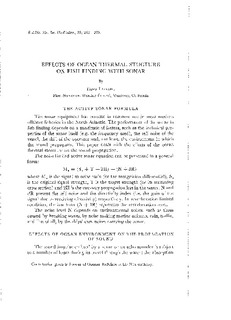| dc.contributor.author | Laevastu, Taivo | |
| dc.date.accessioned | 2008-11-21T09:48:21Z | |
| dc.date.issued | 1969 | |
| dc.identifier.uri | http://hdl.handle.net/11250/114690 | |
| dc.description.abstract | 1. The width of the sound beam trapped in the surface channel depends,
besides on MLD and INGRAD, also on SST. The latter relation is
brought about by nonlinearity in the sound speed dependence on
temperature and depth (Fig. 4).
2. The bottom bounce beam width depends primarily on the temperature
gradient and magnitude of change in the thermocline. With limited
sonar beam width, the area near the ship below the thermocline is not
accessible to horizontal beams (Fig. 5).
3. The distance to the "partial shadow zone" depends primarily on
MLD, but is also affected by SST (Fig. 6).
4. If the INGRAD is more negative than -0.15°C per 30 m, there is no
surface channel propagation. The distance at which the sonified field
in the surface channel ends, depends on INGRAD and MLD (Fig. 7). | |
| dc.format.extent | 268418 bytes | |
| dc.format.mimetype | application/pdf | |
| dc.language.iso | eng | en |
| dc.publisher | [Fiskeridirektoratets havforskningsinstitutt] | en |
| dc.relation.ispartofseries | Fiskeridirektoratets skrifter, Serie Havundersøkelser | en |
| dc.relation.ispartofseries | vol 15 no 3 | en |
| dc.title | Effects of ocean thermal structure on fish finding with sonar | en |
| dc.type | Research report | en |
| dc.source.pagenumber | s. 202-209 | en |
